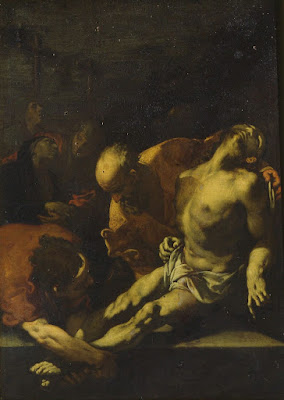 |
| Christoph Gertner Amorous Couple, with Death lurking in the Shadows ca. 1600 oil on slate Národní Galerie, Prague |
 |
| Hendrick van Steenwyck the Younger Esther and Mordecai (scene from the Biblical book of Esther) 1616 oil on panel National Gallery of Art, Washington DC |
 |
| attributed to Luciano Borzone Portrait of Pompilio Ambanelli ca. 1620 oil on canvas Galleria Nazionale di Parma |
 |
| David Teniers the Younger Dinner in the Barn 1634 oil on panel Staatliche Kunsthalle, Karlsruhe |
 |
| attributed to Francesco Cairo Martyrdom of St Agnes 1635 oil on canvas Galleria Sabauda, Turin |
 |
| attributed to Govert Flinck Study Head of Young Man ca. 1637 oil on canvas Leiden Collection, New York |
 |
| Gerard ter Borch A Musical Company ca. 1642-44 oil on panel Leiden Collection, New York |
 |
| Pieter Verelst Head of an Old Man 1648 oil on panel Musée des Augustins de Toulouse |
 |
| Michiel Sweerts Woman Spinning ca. 1656 oil on canvas Museum Gouda |
 |
| Anonymous Dutch Artist working in Dordrecht Still Life ca. 1660-80 oil on panel Leiden Collection, New York |
 |
| Onorio Marinari Mater Dolorosa ca. 1670-80 oil on canvas John and Mable Ringling Museum of Art, Sarasota |
 |
| Anonymous Lombard Artist The Deposition ca. 1680-90 oil on panel Galleria Nazionale di Parma |
 |
| Pompeo Batoni Vulcan at the Forge 1750 oil on canvas National Gallery of Canada, Ottawa |
 |
| Franz Anton Maulbertsch Abraham prevented from sacrificing Isaac ca. 1755 oil on canvas Museum of Fine Arts, Budapest |
 |
| Francisco Goya Portrait of army doctor José Queraltó 1802 oil on canvas Neue Pinakothek, Munich |
 |
| Théodule Ribot The Empty Bottle ca. 1876-81 oil on canvas Städel Museum, Frankfurt |
Men improve with the Years
A weather-worn, marble triton
Among the streams;
Upon this lady's beauty
As though I had found in a book
A pictured beauty,
Pleased to have filled the eyes
Or the discerning ears,
Delighted to be but wise,
For men improve with the years;
And yet, and yet,
O would that we had met
When I had my burning youth!
But I grow old among dreams,
Among the streams.
– W.B. Yeats (1919)






-Servant-in-Kitchen-announcing-the-Miracle-1953-oil-on-canvas-Beaverbrook-Art-Gallery-Fredericton-New-Brunswick.jpg)









-Crucifixion-c1550-oil-on-panel-N%C3%A1rodn%C3%AD-Galerie-Prague.jpeg)
-Rhode-Island-School-of-Design-Providence.jpg)
-Dead-Christ-mourned-by-Angels-c1590-oil-on-black-marble-N%C3%A1rodn%C3%AD-Galerie-Prague.jpeg)

-c1615-oil-on-canvas-Mus%C3%A9e-des-Beaux-Arts-de-Caen.jpg)
-Dead-Christ-in-the-Tomb-c1616-17-oil-on-slate-Galleria-Borghese-Rome.jpg)










-National-Gallery-of-Australia-Canberra.jpg)










-The-Old-Man-Photographs-the-Young-Man-1978-gelatin-silver-print-National-Gallery-of-Australia-Canberra.jpg)

-Racine-Art-Museum-Wisconsin.jpg)

